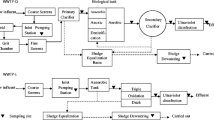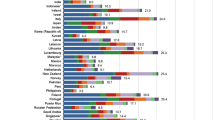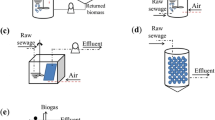Abstract
The high levels of antibiotic residues in pharmaceutical wastewater treatment plants (PWWTPs) make these plants the hotspots for the proliferation of antibiotic resistance genes (ARGs). This study investigated the fate and removal of 11 ARG subtypes for sulfonamide, tetracycline, β-lactam, and macrolide resistance in each processing stage of two full-scale PWWTPs in northern China. The levels of typical ARG subtypes in the final effluents ranged from (2.56 ± 0.13) × 101 to (2.36 ± 0.11) × 107 copies/ml. The absolute abundance of ARGs in effluents accounted for only 0.03–78.1 % of influents of the two PWWTPs, while the majority of the ARGs were transported to the dewatered sludge with concentrations from (2.65 ± 0.43) × 105 to (4.27 ± 0.03) × 1010 copies/g dry weight (dw). The total loads of ARGs discharged through dewatered sludge plus effluent was 1.01–14.09-fold higher than that in the raw influents, suggesting the proliferation of ARGs occurred in the wastewater treatment. The proliferation of ARGs mainly occurs in biological treatment process, such as aeration tank, anoxic tank, sequencing batch reactor (SBR), and bio-contact oxidation, facilitates the proliferation of various ARGs, implying significant replication of certain ARG subtypes may be attributable to microbial growth. Chemical oxidation seems promising to remove ARGs, with removal efficiency ranged from 29.3 to 85.7 %, while the partial correlation analysis showed significant correlations between antibiotic concentration and ARG removal. Thus, the high antibiotic residues within the PWWTPs may have an influence on the proliferation, fate, and removal of the associated ARG subtypes.



Similar content being viewed by others
References
Auerbach EA, Seyfried EE, McMahon KD (2007) Tetracycline resistance genes in activated sludge wastewater treatment plants. Water Res 41(5):1143–1151
Cengiz M, Uslu MO, Balcioglu I (2010) Treatment of E. coil HB101 and the tetM gene by Fenton’s reagent and ozone in cow manure. J Environ Manag 91(12):2590–2593
Chen H, Zhang MM (2013) Occurrence and removal of antibiotic resistance genes in municipal wastewater and rural domestic sewage treatment systems in eastern China. Environ Int 55:9–14
Cheng WX, Chen H, Su C, Yan SH (2013) Abundance and persistence of antibiotic resistance genes in livestock farms: a comprehensive investigation in eastern China. Environ Int 61:1–7
De Leener E, Martel A, Decostere A, Haesebrouck F (2004) Distribution of the erm(B) gene, tetracycline resistance genes, and Tn1545-like Transposons in macrolide- and lincosamide-resistant enterococci from pigs and humans. Microb Drug Resist Mech Epidemiol Dis 10(4):341–345
Deng YQ, Zhang Y, Gao YX, Li D, Liu RY, Liu MM, Zhang HF, Hu B, Yang M (2012) Microbial community compositional analysis for series reactors treating high level antibiotic wastewater. Environ Sci Technol 46(2):795–801
Fick J, Soederström H, Lindberg HR, Phan C, Tyskind M, Larsson DG, Joakim (2009) Contamination of surface, ground, and drinking water from pharmaceutical production. Environ Toxicol Chem 28(12): 2522–2527
Gao PP, Mao DQ, Luo Y, Wang LM, Xu BJ, Xu L (2012) Occurrence of sulfonamide and tetracycline-resistant bacteria and resistance genes in aquaculture environment. Water Res 46(7):2355–2364
García-Galán MJ, Díaz-Cruz MS, Barceló D (2011) Occurrence of sulfonamide residues along the Ebro river basin: removal in wastewater treatment plants and environmental impact assessment. Environ Int 37(2):462–473
Graham DW, Olivares-rieumont S, Knapp CW, Lima L, Werner D, Bowen E (2011) Antibiotic resistance gene abundances associated with waste discharges to the Almendares River near Havana, Cuba. Environ Sci Technol 45:418–424
Guardabassi L, Petersen A, Olsen JE, Dalsgaard A (1998) Antibiotic resistance in Acinetobacter spp. Isolated from sewers receiving waste effluent from a hospital and a pharmaceutical plant. Appl Environ Microbiol 64(9):3499–3502
Gunnarsdottir R, Jenssen PD, Jensen PE, Villumsen A, Kallenborn R (2013) A review of wastewater handling in the Arctic with special reference to pharmaceuticals and personal care products (PPCPs) and microbial pollution. Ecol Eng 50:76–85
Henriques I, Moura A, Alves A, Saavedra MJ, Correia A (2006) Analysing diversity among Î2-lactamase encoding genes in aquatic environments. FEMS Microbiol Ecol 56(3):418–429
Hoa PTP, Nonaka L, Hung PV, Suzuki S (2008) Detection of the sul1, sul2, and sul3 genes in sulfonamide-resistant bacteria from wastewater and shrimp ponds of north Vietnam. Sci Total Environ 405(1–3):377–384
Huang JJ, Hu HY, Tang F, Li Y, Lu SQ, Lu Y (2011) Inactivation and reactivation of antibiotic-resistant bacteria by chlorination in secondary effluents of a municipal wastewater treatment plant. Water Res 45(9):2775–2781
Huang JJ, Hu HY, Lu SQ, Tang F, Lu Y, Wei B (2012a) Monitoring and evaluation of antibiotic-resistant bacteria at a municipal wastewater treatment plant in China. Environ Int 42:31–36
Huang XZ, Frye JG, Chahine MA, Glenn LM, Ake JA, Su W, Nikonlichm MP, Lesho EP (2012b) Characteristics of plasmids in multi-drug-resistant enterobacteriaceae isolated during prospective surveillance of a newly opened hospital in Iraq. PLoS ONE 7(7):1–8
Huang JJ, Hu HY, Wu YH, Wei B, Lu Y (2013) Effect of chlorination and ultraviolet disinfection on tetA-mediated tetracycline resistance of Escherichia coli. Chemosphere 90(8):2247–2253
Kim SR, Nonaka L, Suzuki S (2004) Occurrence of tetracycline resistance genes tet(M) and tet(S) in bacteria from marine aquaculture sites. FEMS Microbiol Lett 237(1):147–156
Koningstein M, Simonsen J, Helms M, Molbak K (2010) The interaction between prior antimicrobial drug exposure and resistance in human Salmonella infections. J Antimicrob Chemother 65(8):1819–1825
Korzeniewska E, Korzeniewska A, Harnisz M (2013) Antibiotic resistant Escherichia coli in hospital and municipal sewage and their emission to the environment. Ecotoxicol Environ Saf 91:96–102
Li JY, Wang J, Xie MJ (2013) Screening and evaluation on bioassays of antibiotic pollutants toxicity on activated sludge. Chin J Environ Eng 5:072
Liu M, Zhang Y, Yang M, Tian Z, Ren L, Zhang S (2012) Abundance and distribution of tetracycline resistance genes and mobile elements in an oxytetracycline production wastewater treatment system. Environ Sci Technol 46(14):7551–7557
Luo Y, Mao DQ, Rysz M, Zhou QX, Zhang HJ, Xu L, Alvarez PJJ (2010) Trends in antibiotic resistance genes occurrence in the Haihe river, China. Environ Sci Technol 44(19):7220–7225
Luo Y, Yang FX, Mathieu J, Mao DQ, Wang Q, Alvarez PJJ (2014) Proliferation of multidrug-resistant New Delhi Metallo-β-lactamase genes in municipal wastewater treatment plants in Northern China. Environ Sci Technol Lett 1(1):26–30
Mancini P, Fertels S, Nave D, Gealt MA (1987) Mobilization of plasmid pHSV106 from Escherichia coli HB101 in a laboratory-scale waste treatment facility. Appl Environ Microbiol 53(4):665–671
McKinney CW, Pruden A (2012) Ultraviolet disinfection of antibiotic resistant bacteria and their antibiotic resistance genes in water and wastewater. Environ Sci Technol 46(24):13393–13400
Munir M, Wong K, Xagoraraki I (2011) Release of antibiotic resistant bacteria and genes in the effluent and biosolids of five wastewater utilities in Michigan. Water Res 45(2):681–693
Murat C, Otker UM, Isil B (2010) Treatment of E. coil HB101 and the tetM gene by Fenton’s reagent and ozone in cow manure. J Environ Manag 91(12):2590–2593
Oberle K, Capdeville MJ, Berthe T, Budzinski H, Petit F (2012) Evidence for a complex relationship between antibiotics and antibiotic-resistant Escherichia coli: from medical center patients to a receiving environment. Environ Sci Technol 46(3):1859–1868
Okuda T, Yamashita N, Tanaka H, Matsukawa H, Tanabe K (2009) Development of extraction method of pharmaceuticals and their occurrences found in Japanese wastewater treatment plants. Environ Int 35(5):815–820
Pei R, Kim S-C, Carlson KH, Pruden A (2006) Effect of River Landscape on the sediment concentrations of antibiotics and corresponding antibiotic resistance genes (ARG). Water Res 40(12):2427–2435
Pruden A, Pei R, Storteboom H, Carlson KH (2006) Antibiotic resistance genes as emerging contaminants: studies in northern Colorado. Environ Sci Technol 40(23):7445–7450
Ram S, Vajpayee P, Singh RL, Shankei R (2009) Surface water of a perennial river exhibits multi-antimicrobial resistant shiga toxin and enterotoxin producing Escherichia coli. Ecotoxicol Environ Saf 72(2):490–495
Shi P, Jia S, Zhang XX, Zhang T, Cheng SP, Li AM (2013) Metagenomic insights into chlorination effects on microbial antibiotic resistance in drinking water. Water Res 47(1):111–120
Tao R, Ying GG, Su HC, Zhou HW, Sidhu JPS (2010) Detection of antibiotic resistance and tetracycline resistance genes in Enterobacteriaceae isolated from the Pearl rivers in South China. Environ Pollut 158(6):2101–2109
Volkmann H, Schwartz T, Bischoff P, Kirchen S, Obst U (2004) Detection of clinically relevant antibiotic-resistance genes in municipal wastewater using real-time PCR (TaqMan). J Microbiol Methods 56(2):277–286
Wang JL, Mao DQ, Mu QH, Luo Y (2015) Fate and proliferation of typicla antibiotic resistance genes in five full-scale pharmaceutical wastewater treatment plants. Sci Total Environ 256:366--373
Zhang XX, Zhang T (2011) Occurrence, abundance, and diversity of tetracycline resistance genes in 15 sewage treatment plants across China and other global location. Environ Sci Technol 45(7):2598–2604
Zhang T, Zhang M, Zhang X, Fang HH (2009a) Tetracycline resistance genes and tetracycline resistant lactose-fermenting enterobacteriaceae in activated sludge of sewage treatment plants. Environ Sci Technol 43(10):3455–3460
Zhang YL, Marrs CF, Simon C, Xi C (2009b) Wastewater treatment contributes to selective increase of antibiotic resistance among Acinetobacter spp. Sci Total Environ 407(12):3702–3706
Zhuang Y, Ren H, Geng J, Zhang Y, Zhang Y, Ding L, Xu K (2015) Inactivation of antibiotic resistance genes in municipal wastewater by chlorination, ultraviolet, and ozonation disinfection. Environ Sci Pollut Res 22(9):7037–7044
Zou SC, Zhu CJ, He ZM, Luan TG, Xu WH, Zhang G (2009) Preliminary studies on the pollution levels of antibiotic resistance genes in the water of Beijiang River, South China. Asian J Ecotoxicol 4(5):655–660
Acknowledgments
This study was supported by the China National Funds for Distinguished Young Scientists (grant 41525013) and National Natural Science Foundation of China (grants 21277075 and 31470440).
Author information
Authors and Affiliations
Corresponding authors
Additional information
Responsible editor: Gerald Thouand
Wenchao Zhai and Fengxia Yang contributed equally to this work.
Electronic supplementary material
Below is the link to the electronic supplementary material.
ESM 1
Detailed information on detection of antibiotics, PCR assays operation, primer sequences of 16S rRNA and ARGs, primary date of gene concentrations in the effluent of each stage of PWWTPs, and the significant correlation between 16S rRNA and ARGs. (DOCX 134 kb)
Rights and permissions
About this article
Cite this article
Zhai, W., Yang, F., Mao, D. et al. Fate and removal of various antibiotic resistance genes in typical pharmaceutical wastewater treatment systems. Environ Sci Pollut Res 23, 12030–12038 (2016). https://doi.org/10.1007/s11356-016-6350-9
Received:
Accepted:
Published:
Issue Date:
DOI: https://doi.org/10.1007/s11356-016-6350-9




